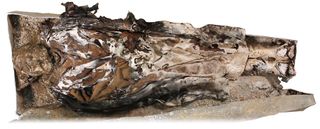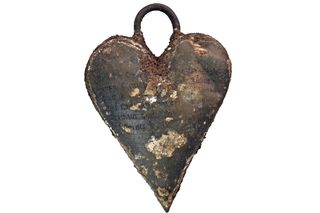Their Hearts Were in It: One Renaissance Couple's Final Gesture

Forget roses and chocolates. Modern-day romantic gestures pale in comparison to what one Renaissance couple did after death: The wife went to her final rest with her husband's heart on her coffin.
The heart of Toussaint de Perrien, a patron of religious orders in Brittany, France, was cut from his chest after death, placed in a heart-shaped lead urn and put on top of his wife's coffin 125 miles (201 kilometers) from his own grave. The body of his wife, Louise de Quengo, had been opened after death and her heart removed, perhaps to rest with her husband (though it has not been found).
De Quengo died in 1656 at age 65, seven years after her husband's death, according to inscriptions on her tomb. The couple weren't the only ones in this time period to undergo postmortem heart removal: An analysis of 483 complete skeletons and 5,940 partial skeletons at the convent where de Quengo was buried found that 18 of the bodies and 17 of the partial remains showed signs of abdomens or skulls opened after death, with some hearts removed. Besides Toussaint's, the convent also contained three other lead urns holding hearts. [See Photos of the Mummified Hearts and Renaissance Burial]
The convent at Rennes
The discoveries raise questions about medieval European funerary rites, researchers from the University of Toulouse in France wrote in the study, published in December in the journal PLOS ONE. Researchers had thought that burial rites gradually became more secularized throughout the Middle Ages and into the modern era, but the newly analyzed bodies suggest instead that these old practices, full of magic and religious ritual, were still favored into the Renaissance, which began around 1495 in France.

Researchers analyzed bodies from the Jacobin convent in Rennes, a city that was then the parliamentary seat of Brittany. The convent was the premier burial place for the city's aristocracy, Rozenn Colleter, an anthropologist at the University of Toulouse and the National Institute of Preventive Archaeological Research in France, and colleagues wrote in their journal article. Elites were buried in the convent in two waves, one from the 1300s to the 1400s, the other from the 1500s to the 1700s.
The research team examined 133 bodies from the first period and found them to be mostly clergy and parishioners, plus a mass grave holding the remains of around 30 soldiers. None of those bodies were embalmed. The researchers also examined 483 of the 1,250 bodies buried during the second period. One of them was Louise de Quengo.
A church patron
Louise de Quengo was found buried in a lead coffin, an expensive choice that only the wealthiest in the city would have been able to afford. She was buried in a rough twill dress and shirt, a black coat and a set of veils in the style of a nun — religious clothing that would have indicated her dedication to the Jacobin Order (a Catholic religious order). De Quengo was a church benefactor who died on March 10, 1656, according to inscriptions on her tomb. Her body had naturally mummified after being sealed in her lead coffin, preserving a cross-shaped incision, roughly stitched, in her chest — where her heart was removed after death. Her other organs were left intact. Her husband's heart was perched atop her coffin; he had died on Aug. 30, 1649. [The Science of Death: 10 Tales from the Crypt & Beyond]
Sign up for the Live Science daily newsletter now
Get the world’s most fascinating discoveries delivered straight to your inbox.
There were three other heart urns in the convent, all found buried at the foot of a lead coffin in the church choir. They were inscribed with the names Catherine de Tournemine, Monsieur d'Artois and the son of la Boessière. They dated from 1684, 1626 and 1685, respectively. It's possible, Colleter and her colleagues wrote, that these three people were relatives of each other or of someone buried in the convent, but because the death dates span 60 years, they may also be unrelated. During the French Revolution, lead coffins and other objects were often scavenged to make bullets, the researchers wrote, so someone may have hidden the urns in the church choir to protect them.
Other bodies in the convent showed signs of embalming. Four bodies had their chest and skull opened, with the brain and organs removed. Other remains showed signs of sawing or cutting after death.
Some of the corpses in the convent may have been altered for preservation purposes; in other cases, the goal seemed to be to provide the dead with more resting places. In the case of Louise and her husband, the researchers wrote, the removal of the hearts would have allowed the benefactors to honor more than one religious house by their burials. Survivors of the couple would have had more places to pray over their remains — an important ritual because souls were thought to go to purgatory unless their relatives prayed them into heaven. Finally, the researchers wrote, there was the personal side.
The heart-swapped burials allowed "for couples to be reunited in death," they wrote, "a phenomenon that had until now not been noted."
Original article on Live Science.

Stephanie Pappas is a contributing writer for Live Science, covering topics ranging from geoscience to archaeology to the human brain and behavior. She was previously a senior writer for Live Science but is now a freelancer based in Denver, Colorado, and regularly contributes to Scientific American and The Monitor, the monthly magazine of the American Psychological Association. Stephanie received a bachelor's degree in psychology from the University of South Carolina and a graduate certificate in science communication from the University of California, Santa Cruz.